Site Analysis Report
VerifiedAdded on 2023/01/17
|11
|1643
|40
AI Summary
This report provides thorough information about the site assets and liabilities, including physical characteristics, site context, and nature of its surroundings. It also covers internal and external characteristics of the site, developmental constraints, and potential development opportunities.
Contribute Materials
Your contribution can guide someone’s learning journey. Share your
documents today.
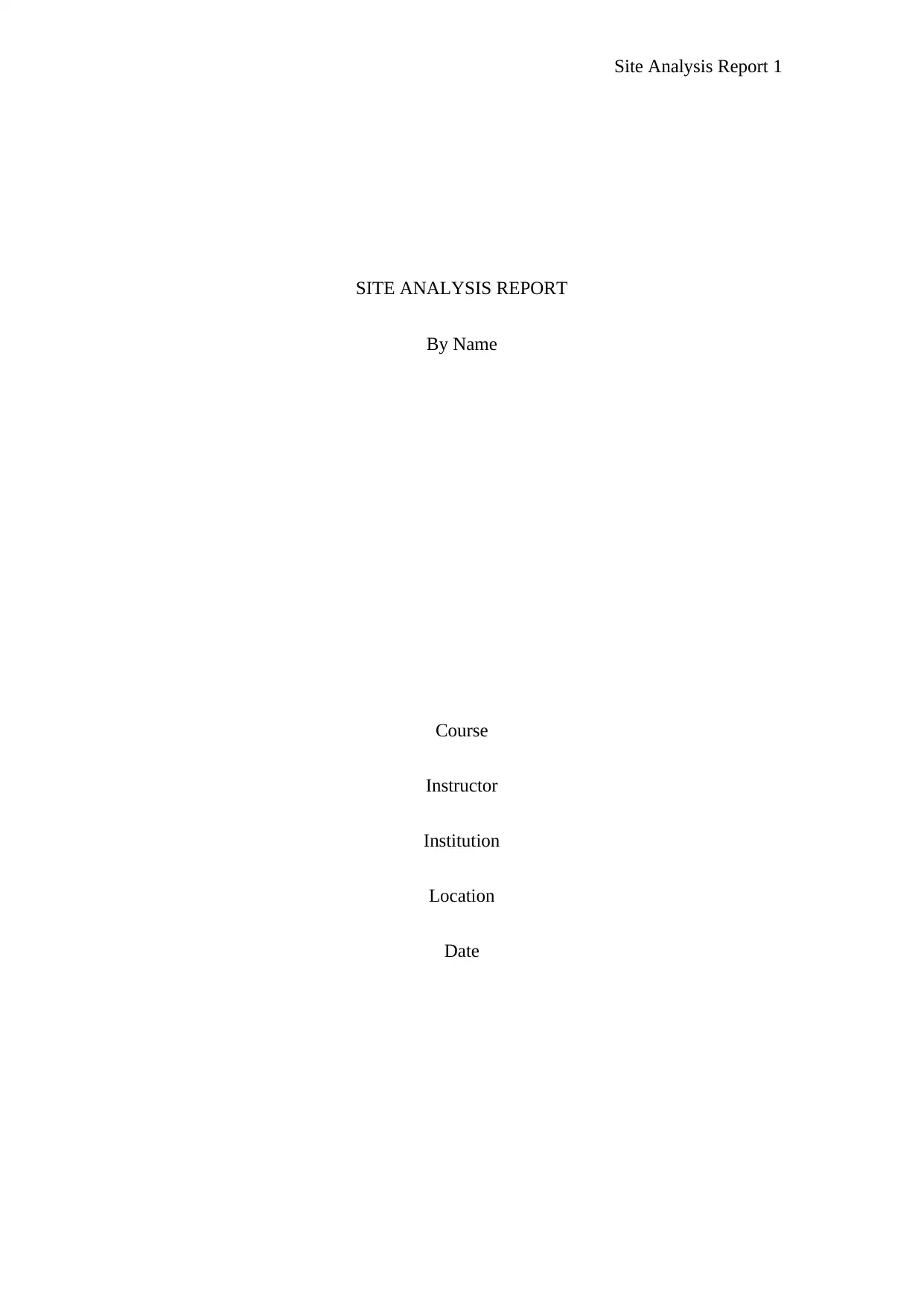
Site Analysis Report 1
SITE ANALYSIS REPORT
By Name
Course
Instructor
Institution
Location
Date
SITE ANALYSIS REPORT
By Name
Course
Instructor
Institution
Location
Date
Secure Best Marks with AI Grader
Need help grading? Try our AI Grader for instant feedback on your assignments.

Site Analysis Report 2
Introduction
The purpose of this report is to provide thorough information about the site assets and
liabilities. This includes the physical characteristics, site context, nature of its wider
surroundings and linkages. It also covers both internal and external characteristics of
the site (LaGro, 2013, p. 628). Developmental constraints have been discussed help
the client identify potential development.
Site Location
The Site is located at the junction of Pulteney Street and Angas Street in Adelaide city
centre, South Australia. Bewes Street passes on its Eastern side parallel to Pulteney
Street. It is legally identified as Allotment 290 - 304.
Site Context
Adelaide city is the capital city of the state of South Australia, and one of the most
populated cities of Australia (mcFee, 2017, p. 730). The site is surrounded by
Simonds Homes on the north and The Mill Creative Studios on the northeast. On the
western side, there is Adelaide Regent Apartments and Carrington Gardens
Apartments. Adelaide Computer Superstore is located on the southern side and gas
station on the western side.
The Site
There are no build structures on the existing allotments. The site is zoned as a
commercial with a building line of three meters from both Pulteney Street and Angas
and Bewes Street (Turney, 2012, p. 115).
Introduction
The purpose of this report is to provide thorough information about the site assets and
liabilities. This includes the physical characteristics, site context, nature of its wider
surroundings and linkages. It also covers both internal and external characteristics of
the site (LaGro, 2013, p. 628). Developmental constraints have been discussed help
the client identify potential development.
Site Location
The Site is located at the junction of Pulteney Street and Angas Street in Adelaide city
centre, South Australia. Bewes Street passes on its Eastern side parallel to Pulteney
Street. It is legally identified as Allotment 290 - 304.
Site Context
Adelaide city is the capital city of the state of South Australia, and one of the most
populated cities of Australia (mcFee, 2017, p. 730). The site is surrounded by
Simonds Homes on the north and The Mill Creative Studios on the northeast. On the
western side, there is Adelaide Regent Apartments and Carrington Gardens
Apartments. Adelaide Computer Superstore is located on the southern side and gas
station on the western side.
The Site
There are no build structures on the existing allotments. The site is zoned as a
commercial with a building line of three meters from both Pulteney Street and Angas
and Bewes Street (Turney, 2012, p. 115).
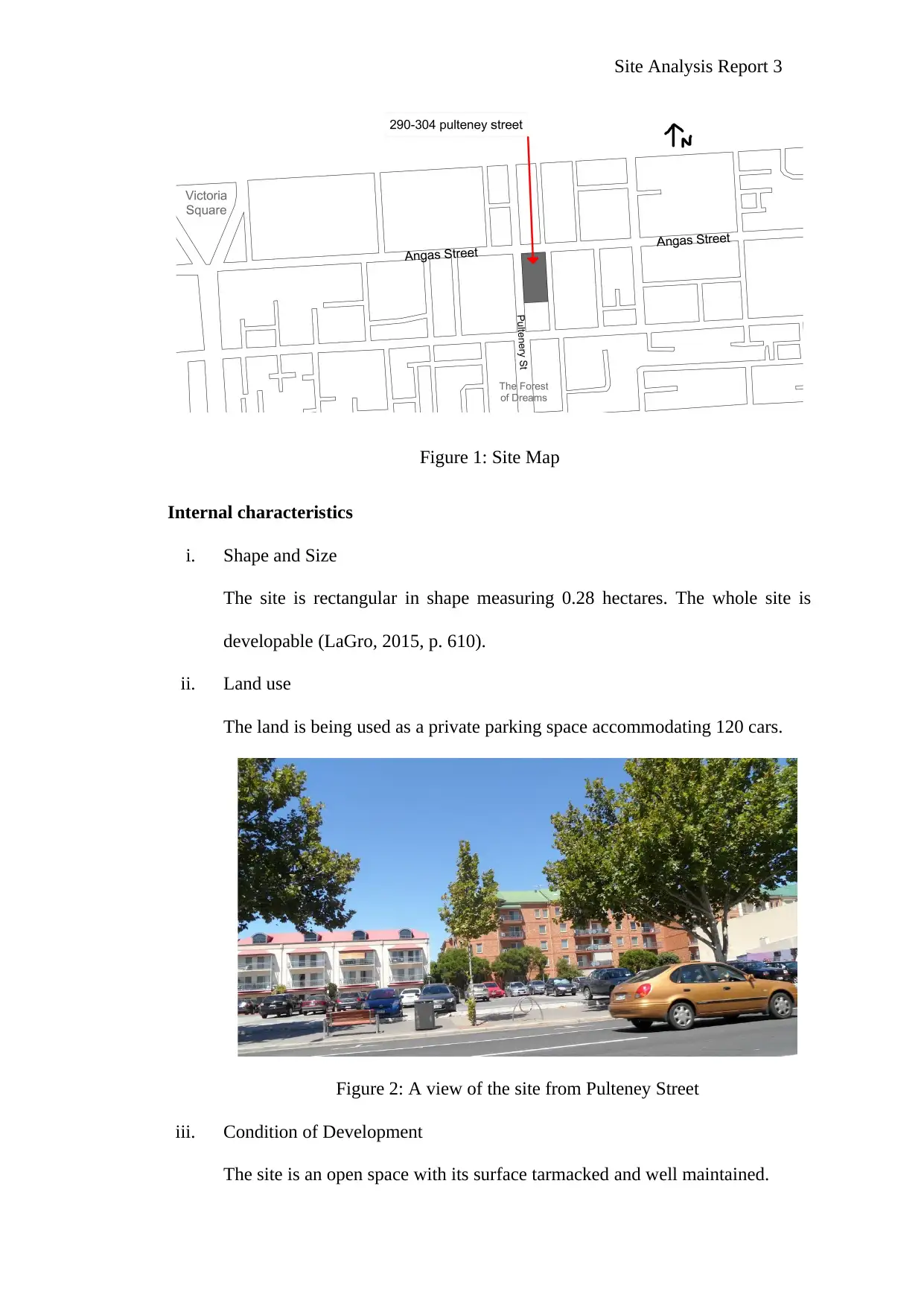
Site Analysis Report 3
Figure 1: Site Map
Internal characteristics
i. Shape and Size
The site is rectangular in shape measuring 0.28 hectares. The whole site is
developable (LaGro, 2015, p. 610).
ii. Land use
The land is being used as a private parking space accommodating 120 cars.
Figure 2: A view of the site from Pulteney Street
iii. Condition of Development
The site is an open space with its surface tarmacked and well maintained.
Figure 1: Site Map
Internal characteristics
i. Shape and Size
The site is rectangular in shape measuring 0.28 hectares. The whole site is
developable (LaGro, 2015, p. 610).
ii. Land use
The land is being used as a private parking space accommodating 120 cars.
Figure 2: A view of the site from Pulteney Street
iii. Condition of Development
The site is an open space with its surface tarmacked and well maintained.
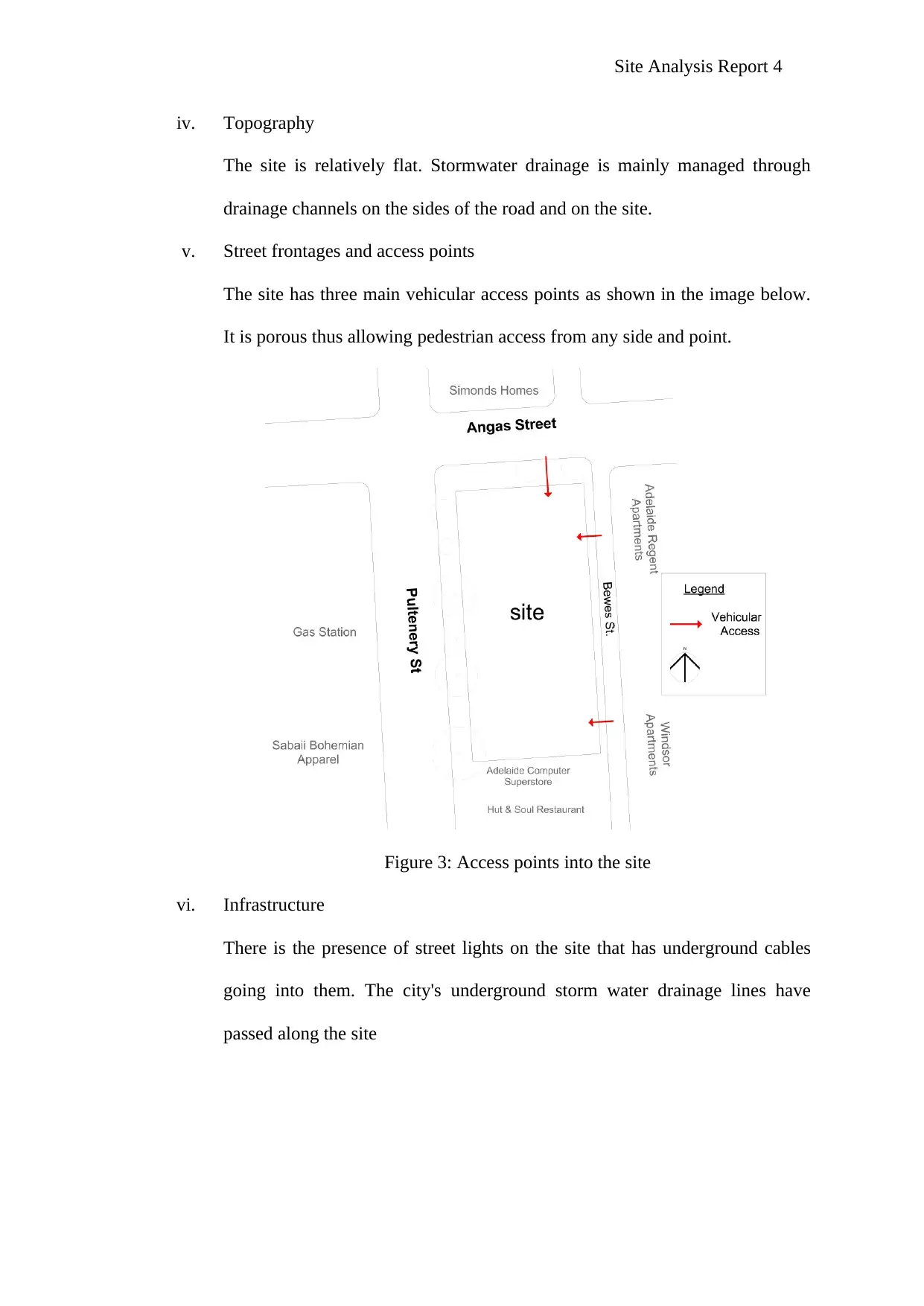
Site Analysis Report 4
iv. Topography
The site is relatively flat. Stormwater drainage is mainly managed through
drainage channels on the sides of the road and on the site.
v. Street frontages and access points
The site has three main vehicular access points as shown in the image below.
It is porous thus allowing pedestrian access from any side and point.
Figure 3: Access points into the site
vi. Infrastructure
There is the presence of street lights on the site that has underground cables
going into them. The city's underground storm water drainage lines have
passed along the site
iv. Topography
The site is relatively flat. Stormwater drainage is mainly managed through
drainage channels on the sides of the road and on the site.
v. Street frontages and access points
The site has three main vehicular access points as shown in the image below.
It is porous thus allowing pedestrian access from any side and point.
Figure 3: Access points into the site
vi. Infrastructure
There is the presence of street lights on the site that has underground cables
going into them. The city's underground storm water drainage lines have
passed along the site
Paraphrase This Document
Need a fresh take? Get an instant paraphrase of this document with our AI Paraphraser
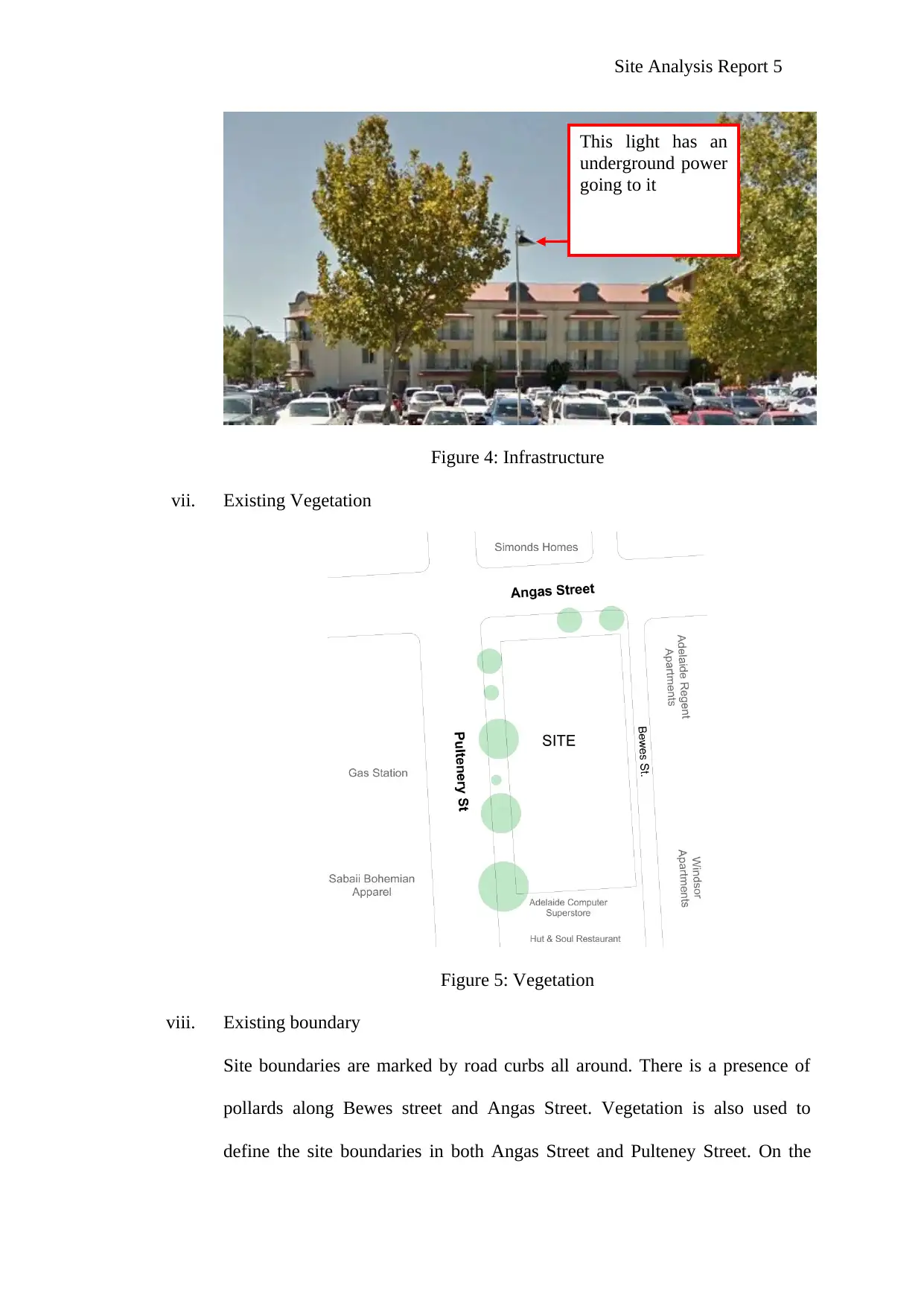
Site Analysis Report 5
Figure 4: Infrastructure
vii. Existing Vegetation
Figure 5: Vegetation
viii. Existing boundary
Site boundaries are marked by road curbs all around. There is a presence of
pollards along Bewes street and Angas Street. Vegetation is also used to
define the site boundaries in both Angas Street and Pulteney Street. On the
This light has an
underground power
going to it
Figure 4: Infrastructure
vii. Existing Vegetation
Figure 5: Vegetation
viii. Existing boundary
Site boundaries are marked by road curbs all around. There is a presence of
pollards along Bewes street and Angas Street. Vegetation is also used to
define the site boundaries in both Angas Street and Pulteney Street. On the
This light has an
underground power
going to it
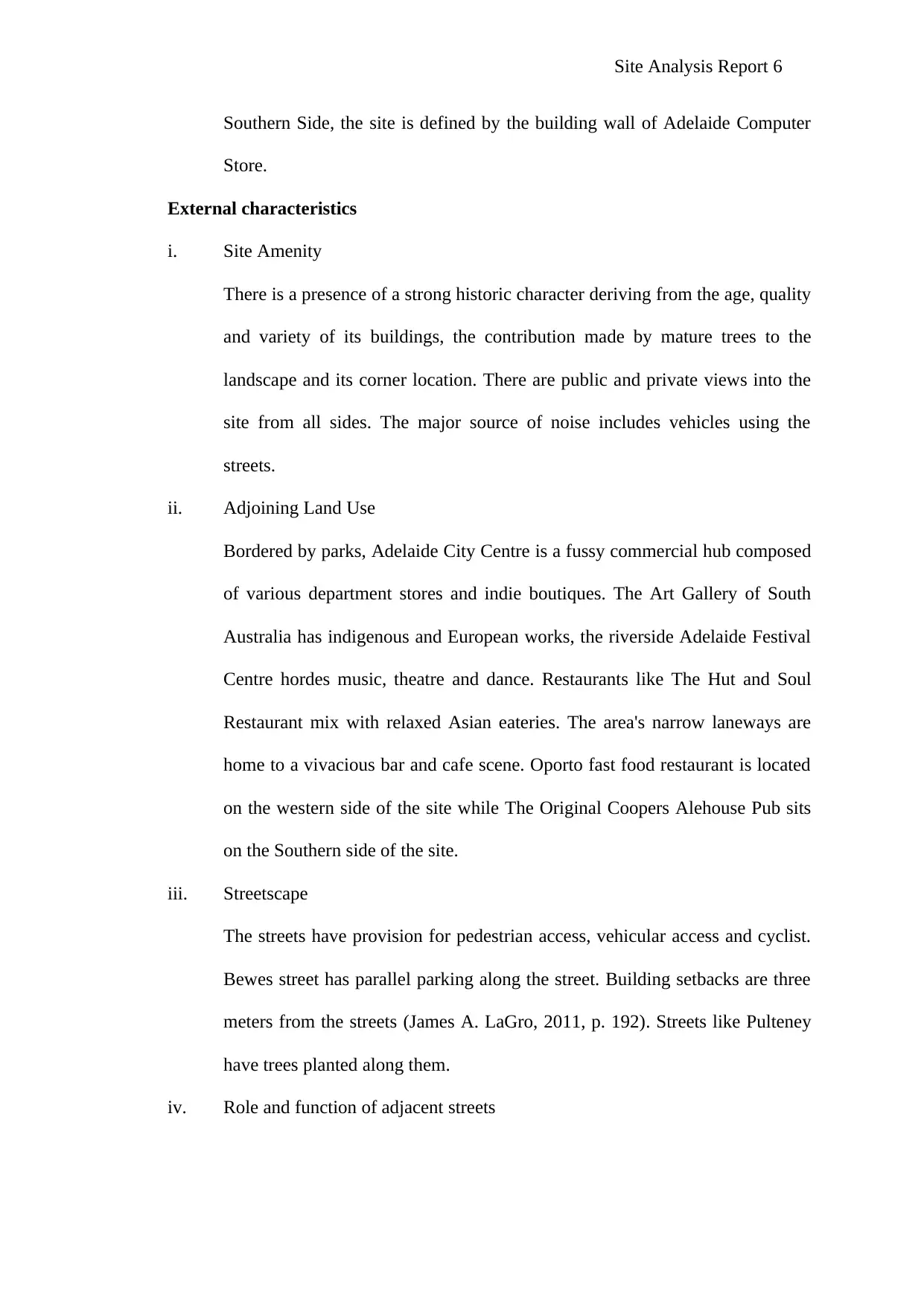
Site Analysis Report 6
Southern Side, the site is defined by the building wall of Adelaide Computer
Store.
External characteristics
i. Site Amenity
There is a presence of a strong historic character deriving from the age, quality
and variety of its buildings, the contribution made by mature trees to the
landscape and its corner location. There are public and private views into the
site from all sides. The major source of noise includes vehicles using the
streets.
ii. Adjoining Land Use
Bordered by parks, Adelaide City Centre is a fussy commercial hub composed
of various department stores and indie boutiques. The Art Gallery of South
Australia has indigenous and European works, the riverside Adelaide Festival
Centre hordes music, theatre and dance. Restaurants like The Hut and Soul
Restaurant mix with relaxed Asian eateries. The area's narrow laneways are
home to a vivacious bar and cafe scene. Oporto fast food restaurant is located
on the western side of the site while The Original Coopers Alehouse Pub sits
on the Southern side of the site.
iii. Streetscape
The streets have provision for pedestrian access, vehicular access and cyclist.
Bewes street has parallel parking along the street. Building setbacks are three
meters from the streets (James A. LaGro, 2011, p. 192). Streets like Pulteney
have trees planted along them.
iv. Role and function of adjacent streets
Southern Side, the site is defined by the building wall of Adelaide Computer
Store.
External characteristics
i. Site Amenity
There is a presence of a strong historic character deriving from the age, quality
and variety of its buildings, the contribution made by mature trees to the
landscape and its corner location. There are public and private views into the
site from all sides. The major source of noise includes vehicles using the
streets.
ii. Adjoining Land Use
Bordered by parks, Adelaide City Centre is a fussy commercial hub composed
of various department stores and indie boutiques. The Art Gallery of South
Australia has indigenous and European works, the riverside Adelaide Festival
Centre hordes music, theatre and dance. Restaurants like The Hut and Soul
Restaurant mix with relaxed Asian eateries. The area's narrow laneways are
home to a vivacious bar and cafe scene. Oporto fast food restaurant is located
on the western side of the site while The Original Coopers Alehouse Pub sits
on the Southern side of the site.
iii. Streetscape
The streets have provision for pedestrian access, vehicular access and cyclist.
Bewes street has parallel parking along the street. Building setbacks are three
meters from the streets (James A. LaGro, 2011, p. 192). Streets like Pulteney
have trees planted along them.
iv. Role and function of adjacent streets

Site Analysis Report 7
Pulteney Street, Angas Street and Bewes Street are vehicular. Cyclist lanes are
provided along Angas Street and Pulteney Street. The surrounding road
network comprises residential streets with footways and footpaths providing
connectivity.
v. Proximity to transport
The site is connected to the primary road, Pulteney Street. Transit bus services
are available along the street. Angas Street provides secondary routes for
vehicular traffic. Cyclists paths are also provided along the streets. Bewes
Street is narrower and does not provide for public transit vehicles.
vi. Proximity to Other Services
Adelaide City Centre is surrounded by a number of accessible parks of varying
size and quality. Approximately 70 meters to the southern side is The Forest of
Dreams. Victoria Square Tarntanyangga Park is about half a kilometre away to
the north-western side of the site.
Figure 5: The Forest of Dreams
Pulteney Street, Angas Street and Bewes Street are vehicular. Cyclist lanes are
provided along Angas Street and Pulteney Street. The surrounding road
network comprises residential streets with footways and footpaths providing
connectivity.
v. Proximity to transport
The site is connected to the primary road, Pulteney Street. Transit bus services
are available along the street. Angas Street provides secondary routes for
vehicular traffic. Cyclists paths are also provided along the streets. Bewes
Street is narrower and does not provide for public transit vehicles.
vi. Proximity to Other Services
Adelaide City Centre is surrounded by a number of accessible parks of varying
size and quality. Approximately 70 meters to the southern side is The Forest of
Dreams. Victoria Square Tarntanyangga Park is about half a kilometre away to
the north-western side of the site.
Figure 5: The Forest of Dreams
Secure Best Marks with AI Grader
Need help grading? Try our AI Grader for instant feedback on your assignments.

Site Analysis Report 8
The parks in Adelaide City are of great value, providing diverse function,
encouraging biodiversity and bring great ecological value to the area. The
local parks and open spaces help to create a specific identity and act as key
local landmarks for space. There is a network of parks and open spaces within
the area ranging from small open spaces to parks and heaths.
vii. Heritage and Conservation
Due to its historic puritan wealth during the 20th century, the city retains a
notable portion of the Victorian architecture. North Terrace is considered
Adelaide's "cultural boulevard" because of its tight concentration of galleries
and museums (Worsnop, 2012, p. 425).
viii. Developments
Presence of SA Police Headquarters in the neighbourhood is likely to boost
security. Fast food and restaurant developments including; Funk Coffee +
Food, Oporto and Le Riad Restaurant are notable in the area. A gas station is
located to the western side of the site as apartments sit on the eastern side of
the site
Development Constraints
i. Land Use Controls
They are minimum standards included within the City's Zoning. Too rigid
zoning standards and do not allow sufficient land use flexibility, hence an
increase in development costs (White, 2016, p. 672). Development interest
may also decrease.
ii. Building Codes
They regulate the physical construction of dwellings and include, for example,
the plumbing, electrical, and mechanical codes.
The parks in Adelaide City are of great value, providing diverse function,
encouraging biodiversity and bring great ecological value to the area. The
local parks and open spaces help to create a specific identity and act as key
local landmarks for space. There is a network of parks and open spaces within
the area ranging from small open spaces to parks and heaths.
vii. Heritage and Conservation
Due to its historic puritan wealth during the 20th century, the city retains a
notable portion of the Victorian architecture. North Terrace is considered
Adelaide's "cultural boulevard" because of its tight concentration of galleries
and museums (Worsnop, 2012, p. 425).
viii. Developments
Presence of SA Police Headquarters in the neighbourhood is likely to boost
security. Fast food and restaurant developments including; Funk Coffee +
Food, Oporto and Le Riad Restaurant are notable in the area. A gas station is
located to the western side of the site as apartments sit on the eastern side of
the site
Development Constraints
i. Land Use Controls
They are minimum standards included within the City's Zoning. Too rigid
zoning standards and do not allow sufficient land use flexibility, hence an
increase in development costs (White, 2016, p. 672). Development interest
may also decrease.
ii. Building Codes
They regulate the physical construction of dwellings and include, for example,
the plumbing, electrical, and mechanical codes.
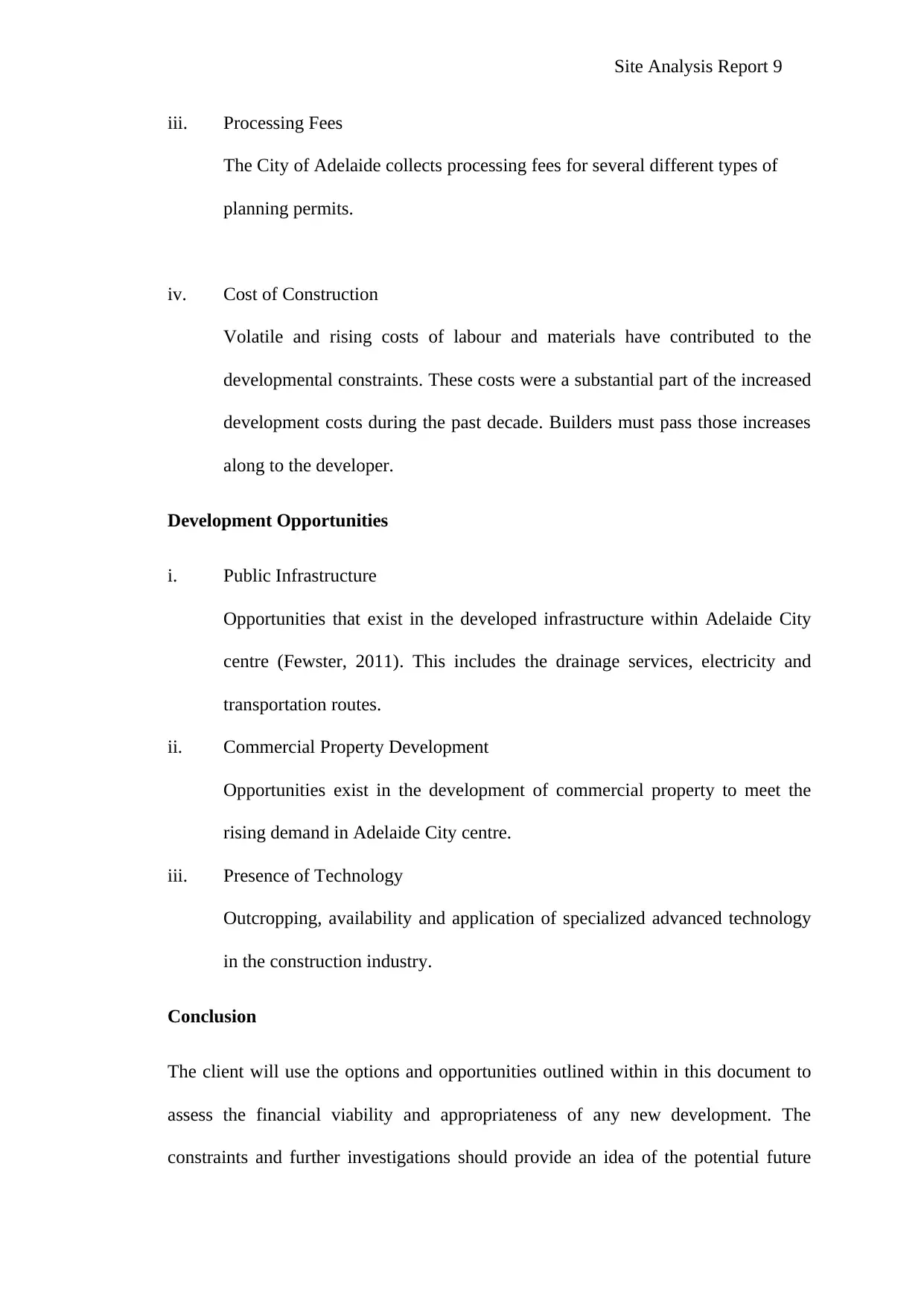
Site Analysis Report 9
iii. Processing Fees
The City of Adelaide collects processing fees for several different types of
planning permits.
iv. Cost of Construction
Volatile and rising costs of labour and materials have contributed to the
developmental constraints. These costs were a substantial part of the increased
development costs during the past decade. Builders must pass those increases
along to the developer.
Development Opportunities
i. Public Infrastructure
Opportunities that exist in the developed infrastructure within Adelaide City
centre (Fewster, 2011). This includes the drainage services, electricity and
transportation routes.
ii. Commercial Property Development
Opportunities exist in the development of commercial property to meet the
rising demand in Adelaide City centre.
iii. Presence of Technology
Outcropping, availability and application of specialized advanced technology
in the construction industry.
Conclusion
The client will use the options and opportunities outlined within in this document to
assess the financial viability and appropriateness of any new development. The
constraints and further investigations should provide an idea of the potential future
iii. Processing Fees
The City of Adelaide collects processing fees for several different types of
planning permits.
iv. Cost of Construction
Volatile and rising costs of labour and materials have contributed to the
developmental constraints. These costs were a substantial part of the increased
development costs during the past decade. Builders must pass those increases
along to the developer.
Development Opportunities
i. Public Infrastructure
Opportunities that exist in the developed infrastructure within Adelaide City
centre (Fewster, 2011). This includes the drainage services, electricity and
transportation routes.
ii. Commercial Property Development
Opportunities exist in the development of commercial property to meet the
rising demand in Adelaide City centre.
iii. Presence of Technology
Outcropping, availability and application of specialized advanced technology
in the construction industry.
Conclusion
The client will use the options and opportunities outlined within in this document to
assess the financial viability and appropriateness of any new development. The
constraints and further investigations should provide an idea of the potential future
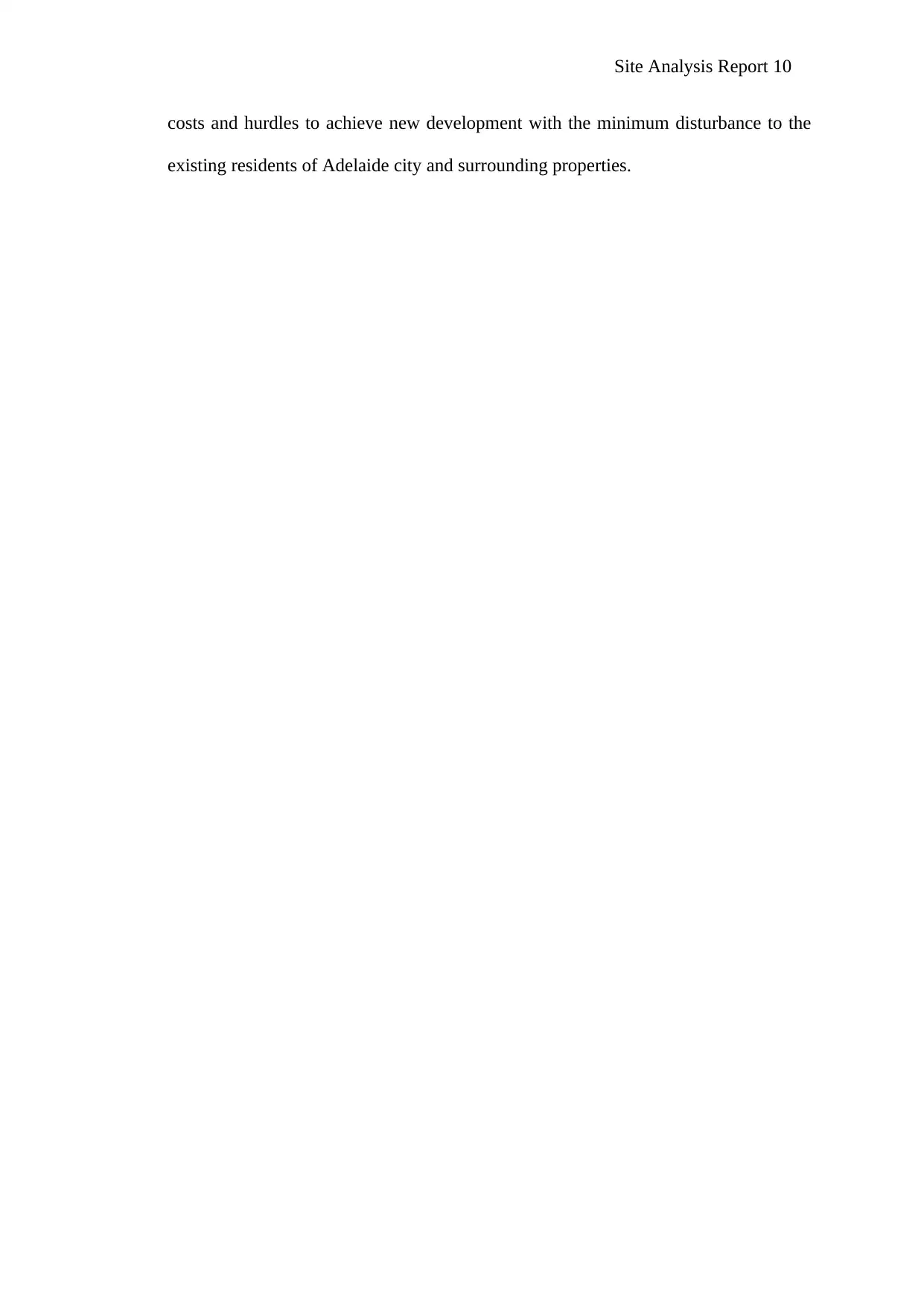
Site Analysis Report 10
costs and hurdles to achieve new development with the minimum disturbance to the
existing residents of Adelaide city and surrounding properties.
costs and hurdles to achieve new development with the minimum disturbance to the
existing residents of Adelaide city and surrounding properties.
Paraphrase This Document
Need a fresh take? Get an instant paraphrase of this document with our AI Paraphraser
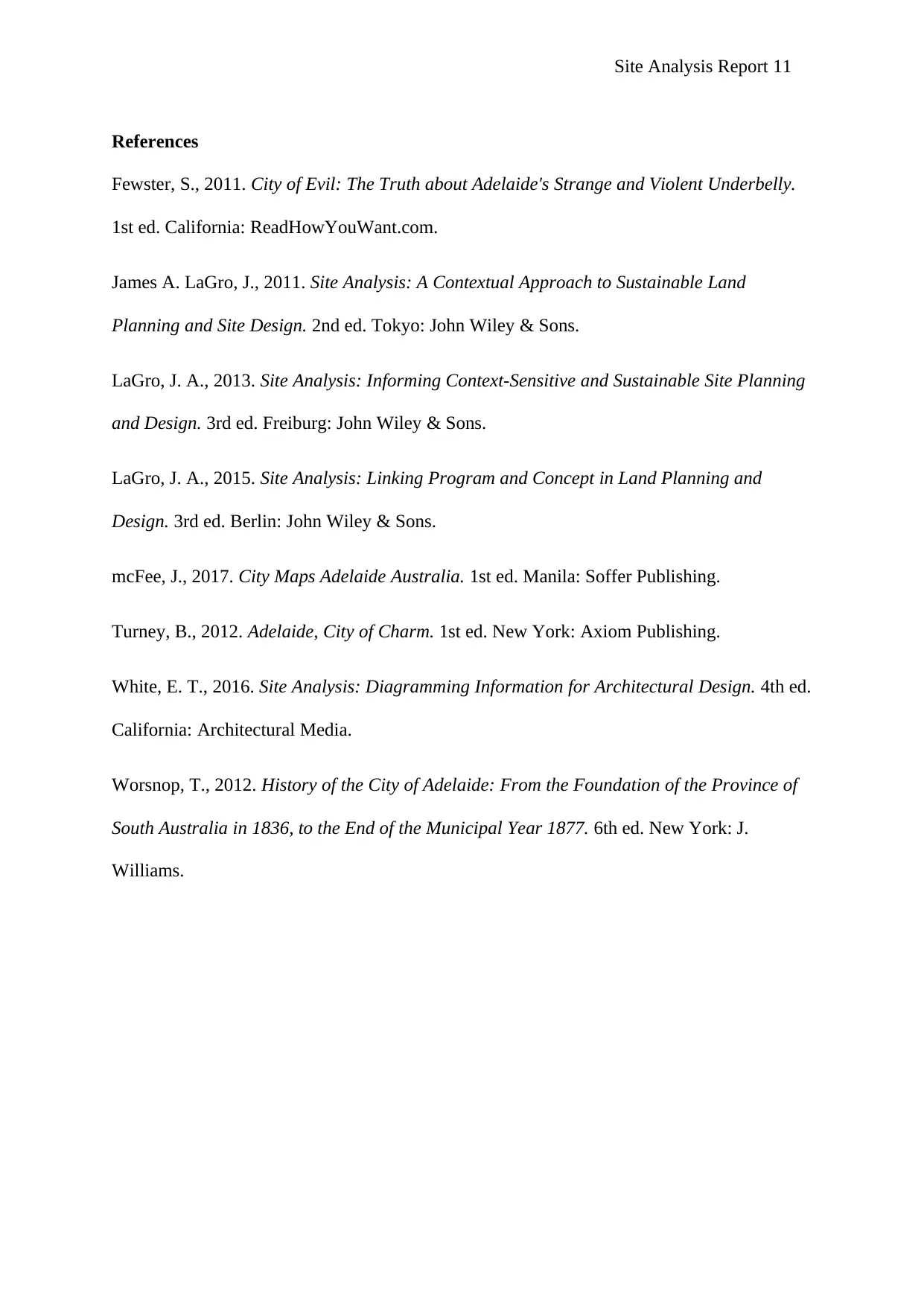
Site Analysis Report 11
References
Fewster, S., 2011. City of Evil: The Truth about Adelaide's Strange and Violent Underbelly.
1st ed. California: ReadHowYouWant.com.
James A. LaGro, J., 2011. Site Analysis: A Contextual Approach to Sustainable Land
Planning and Site Design. 2nd ed. Tokyo: John Wiley & Sons.
LaGro, J. A., 2013. Site Analysis: Informing Context-Sensitive and Sustainable Site Planning
and Design. 3rd ed. Freiburg: John Wiley & Sons.
LaGro, J. A., 2015. Site Analysis: Linking Program and Concept in Land Planning and
Design. 3rd ed. Berlin: John Wiley & Sons.
mcFee, J., 2017. City Maps Adelaide Australia. 1st ed. Manila: Soffer Publishing.
Turney, B., 2012. Adelaide, City of Charm. 1st ed. New York: Axiom Publishing.
White, E. T., 2016. Site Analysis: Diagramming Information for Architectural Design. 4th ed.
California: Architectural Media.
Worsnop, T., 2012. History of the City of Adelaide: From the Foundation of the Province of
South Australia in 1836, to the End of the Municipal Year 1877. 6th ed. New York: J.
Williams.
References
Fewster, S., 2011. City of Evil: The Truth about Adelaide's Strange and Violent Underbelly.
1st ed. California: ReadHowYouWant.com.
James A. LaGro, J., 2011. Site Analysis: A Contextual Approach to Sustainable Land
Planning and Site Design. 2nd ed. Tokyo: John Wiley & Sons.
LaGro, J. A., 2013. Site Analysis: Informing Context-Sensitive and Sustainable Site Planning
and Design. 3rd ed. Freiburg: John Wiley & Sons.
LaGro, J. A., 2015. Site Analysis: Linking Program and Concept in Land Planning and
Design. 3rd ed. Berlin: John Wiley & Sons.
mcFee, J., 2017. City Maps Adelaide Australia. 1st ed. Manila: Soffer Publishing.
Turney, B., 2012. Adelaide, City of Charm. 1st ed. New York: Axiom Publishing.
White, E. T., 2016. Site Analysis: Diagramming Information for Architectural Design. 4th ed.
California: Architectural Media.
Worsnop, T., 2012. History of the City of Adelaide: From the Foundation of the Province of
South Australia in 1836, to the End of the Municipal Year 1877. 6th ed. New York: J.
Williams.
1 out of 11
![[object Object]](/_next/static/media/star-bottom.7253800d.svg)





